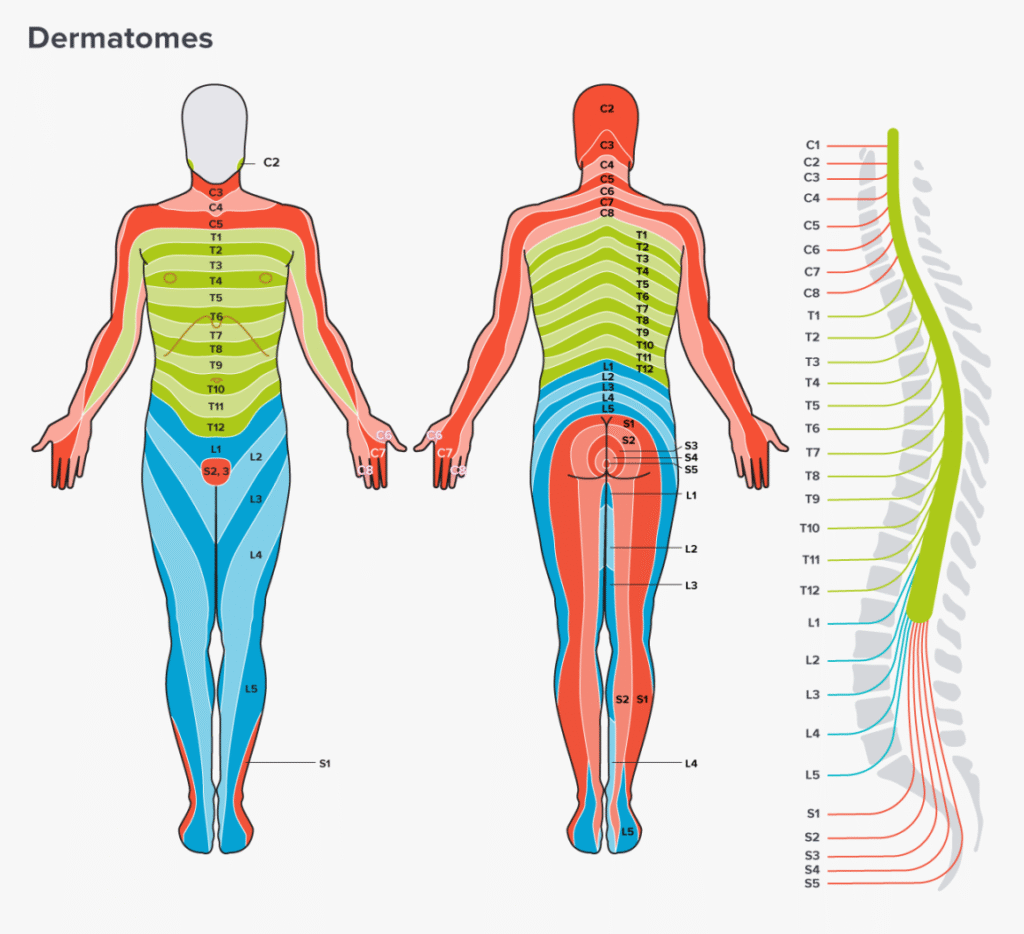Common Conditions
Radicular pain
Radicular pain refers to pain that radiates along the path of a spinal nerve, often extending from the spine to other areas of the body, such as the arms or legs. This type of pain occurs when a spinal nerve is compressed or irritated, usually due to conditions affecting the spinal column. Radicular pain is often sharp, shooting, or burning and is commonly associated with conditions like sciatica or cervical radiculopathy.
What causes radicular pain?
Radicular pain is caused by irritation or compression of a spinal nerve root, which can result from:
- Herniated discs: When a disc between the vertebrae bulges or ruptures, it can press on nearby nerves.
- Spinal stenosis: Narrowing of the spinal canal can compress nerve roots.
- Degenerative disc disease: Age-related changes in the spine can lead to nerve irritation.
- Spondylolisthesis: A condition in which one vertebra slips forward over another, potentially pinching a nerve.
- Bone spurs: Growths on the vertebrae can encroach on the space for nerve roots.
- Trauma or injury: Direct injury to the spine can lead to nerve compression.
- Tumours or infections: Although rare, growths or infections in the spine can irritate or compress nerves.
Common symptoms of radicular pain
The symptoms of radicular pain can vary depending on the location of the affected nerve but often include:
- Radiating pain: A sharp, shooting, or burning pain that follows the path of the nerve. For example, cervical radicular pain may radiate from the neck into the arm, while lumbar radicular pain can extend from the lower back into the leg.
- Numbness or tingling: Sensations of pins and needles in the affected area.
- Weakness: Muscle weakness in the arms, hands, legs, or feet, depending on the nerve involved.
- Pain with specific movements: Activities like bending, twisting, or lifting can worsen the pain.
- Localized pain: Some individuals may also experience pain or tenderness near the spine.
Diagnosis of radicular pain
Diagnosing radicular pain involves assessing symptoms that suggest nerve root irritation, such pain that radiates from the spine into an arm or leg. A specialist will ask about the pattern, severity, and triggers of your pain, along with any numbness, tingling, or muscle weakness. A physical exam includes tests for nerve function, reflexes, and movements that may reproduce your symptoms. Sciatica is an example of a radicular pain.
Imaging tests are typically used to identify the source of nerve compression. These may include:
- MRI scans to detect herniated discs, spinal stenosis, or other causes of nerve impingement.
- CT scans for detailed views of bone structures, especially if MRI is not suitable.
- X-rays to assess spinal alignment or degenerative changes.
In some cases, nerve conduction studies (EMG/NCS) may be used to confirm the involvement and severity of nerve irritation.
Management of radicular pain
Treatment for radicular pain aims to relieve nerve compression and manage symptoms. Options include:
- Conservative management: Rest and avoiding activities that worsen symptoms.
- Medications:
— Over-the-counter pain relievers such as ibuprofen or paracetamol.
— Prescription medications including muscle relaxants or nerve pain medications (e.g., anti-depressants or anti-epileptics). - Physical therapy:
— Exercises to strengthen the supporting muscles, improve flexibility, and reduce pressure on the affected nerve.
— Stretching techniques tailored to the location of the pain. - Injections: Corticosteroid injections near the affected nerve root can help reduce inflammation and provide temporary relief.
- Surgical options: If conservative treatments fail, surgery may be necessary to remove the source of nerve compression, such as a herniated disc or bone spur.


